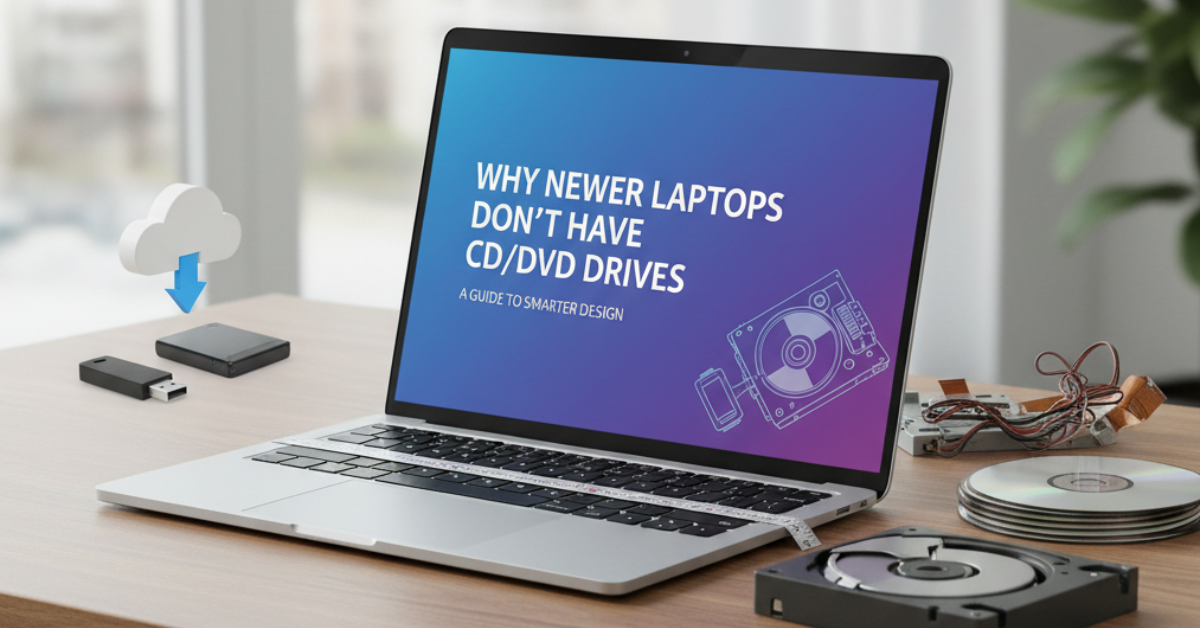Introduction: The Missing CD/DVD Drive
You just found a stack of old photos or a favorite movie on DVD, but your shiny new laptop has no place to put it. It’s a common frustration! You’re not alone in wondering why don’t newer laptops come with CD/DVD drives.
In this article, we’ll break down the five simple reasons behind this change. We’ll also show you easy and affordable ways to use your CDs and DVDs today. Let’s solve this modern tech mystery together.
The Shift Away from Built-in Drives: A Recent History
It feels like just yesterday that a CD/DVD drive was a standard feature on every laptop. So, when did this change happen? The shift away from built-in drives didn’t occur overnight.
Understanding this recent history helps explain why this change is permanent. We’ll look at how quickly this technology became a thing of the past.
5 Key Reasons Why New Laptops Don’t Have CD/DVD Drives
So, why did laptop makers decide to leave out the CD/DVD drive? It wasn’t for just one reason. It was a combination of several smart changes in technology and what people wanted. Think of it like upgrading from a flip phone to a smartphone. The old feature was removed to make way for something better. Here are the five main factors that led to this big design shift.
- The Demand for Thinner, Lighter Laptops. The most obvious reason is size. CD/DVD drives are physically bulky. By removing them, engineers could create the incredibly slim and lightweight laptops we have today, like ultrabooks and 2-in-1 convertibles. This makes them much easier to carry in a backpack all day.
- The Rise of the Internet and Cloud Services. Why carry a stack of discs when you can download or stream everything? Software is bought online (like Microsoft Office), movies and music come from Netflix and Spotify, and games are downloaded from platforms like Steam. The internet made the CD/DVD drive less necessary for everyday tasks.
- Saving Money and Improving Durability. Removing the drive lowers manufacturing costs. This allows companies to use that budget on more important components, like a better screen or a faster processor. Also, with no moving parts, the laptop becomes more reliable and less likely to break from a bump or drop.
- Better Uses for the Space. The space inside a laptop is valuable real estate. Without a drive, that area can be used for a larger battery for all-day life, better cooling systems for improved performance, or more ports for connecting other devices.
- The Need for Better Battery Life. Optical drives use a significant amount of power to spin discs. Removing this power-hungry component was a key step in achieving the long battery life that is now a standard expectation for any modern laptop.
What If You Still Need to Use CDs or DVDs? Your 3 Best Options
Just because your new laptop doesn’t have a built-in drive doesn’t mean you have to abandon your old CDs and DVDs. Luckily, there are several easy and affordable solutions. You can choose the one that best fits how often you need to use your discs.
Here are your three best options for accessing that content today.
- Buy an External DVD Drive (The Easiest Fix): This is the most popular solution. An external drive is a small device that plugs into your laptop’s USB port. It works just like a built-in drive but gives you the flexibility to use it only when you need it. They are surprisingly affordable, often costing between $20 and $50, and are simple plug-and-play devices.
- Convert Your Media to Digital Files (The Long-Term Solution): If you have CDs or DVDs you use often, like a music collection or software installers, you can “rip” them. This means using a computer with a drive (maybe an old desktop or a friend’s laptop) to copy the contents onto your hard drive as an MP3 or ISO file. Once digitized, you’ll never need the physical disc again.
- Share a Drive Over a Network (The Tech-Savvy Choice): If you have another computer in your house that still has a CD/DVD drive, you can set it up to share that drive over your home network. This allows you to access the disc remotely from your new laptop, though it requires a bit more technical setup.
Buying Guide: Laptop with a Drive vs. Laptop + External Drive
You might be tempted to hunt for an older laptop that still has a built-in CD/DVD drive. But is that the best choice? Let’s compare the two options.
Older Laptop with Built-in Drive:
- Pros: The drive is always there.
- Cons: You’ll be using outdated technology. This means slower performance, shorter battery life, and a heavier, bulkier design.
Modern Laptop + External Drive:
- Pros: You get a fast, lightweight, long-lasting modern machine.
- Cons: You have to carry a small external device for the rare times you need it.
Frequently Asked Questions (FAQs)
Do any new laptops still have built-in DVD drives?
Virtually no major brands include them in new mainstream models. Your only option is finding old leftover stock, which means sacrificing modern performance.
Are external DVD drives worth it?
Yes. For around $20-$50, they are an affordable and simple plug-and-play solution for occasional use.
How can I play a DVD on a laptop without a drive?
Use an external USB DVD drive. You may also need free software like VLC Media Player.
Can I install software from a CD?
Yes, by using an external drive or creating a digital ISO file from the CD on another computer.
Why would someone still need a DVD drive?
Common reasons include accessing old archives, installing legacy software, or watching DVD movies.











